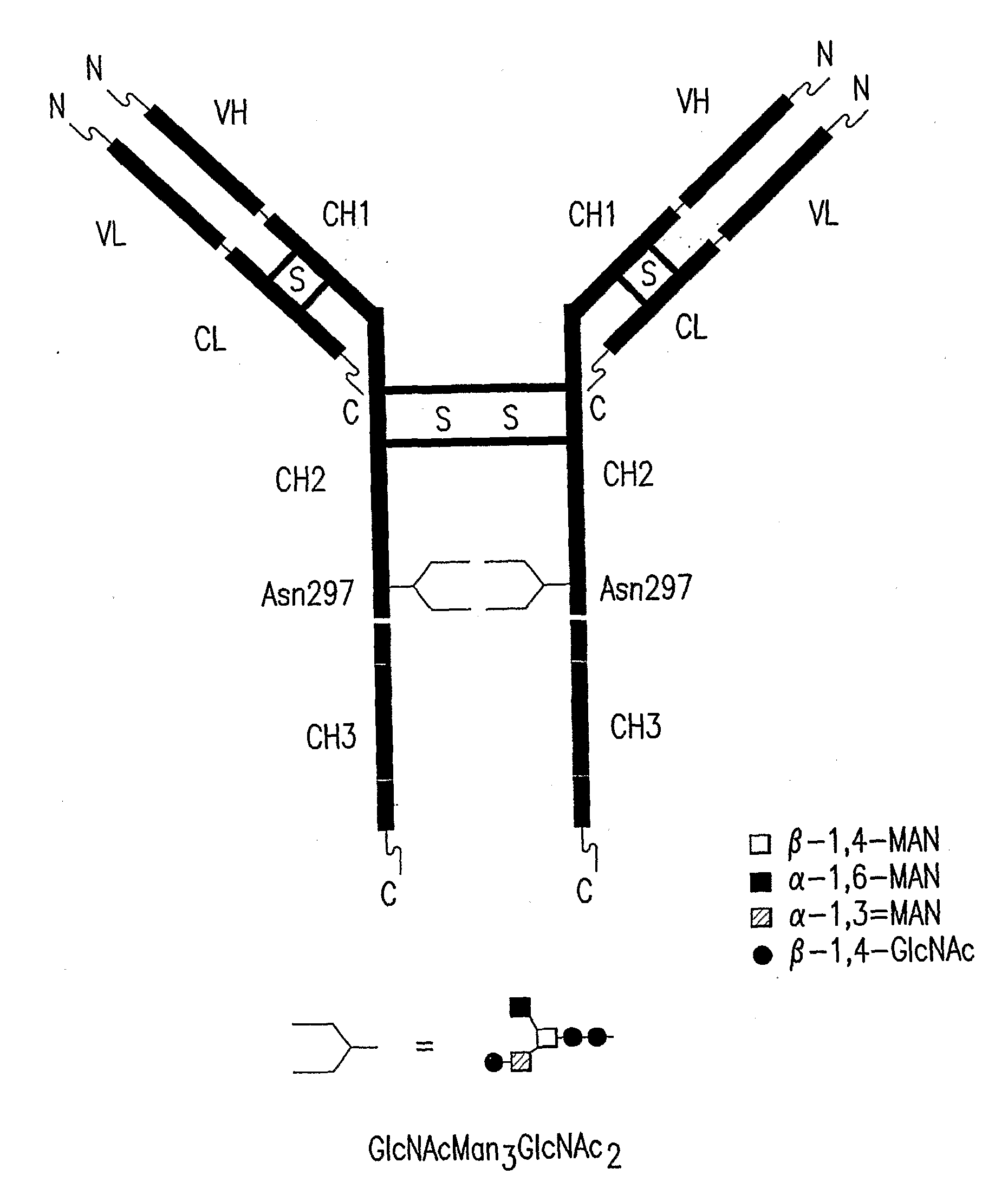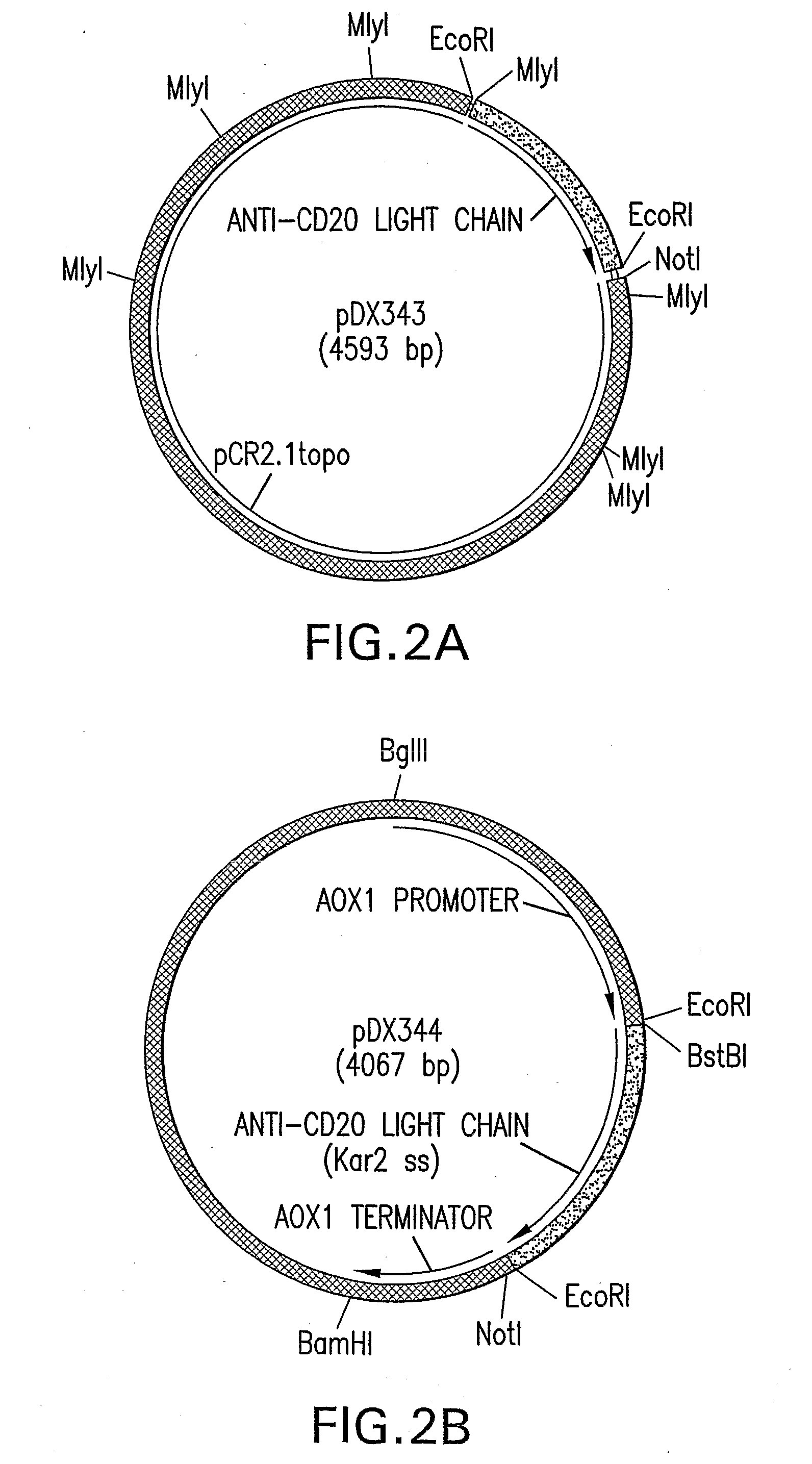Immunoglobulins Comprising Predominantly a Glcnacman3Glcnac2 Glycoform
a glycoform and immunoglobulin technology, applied in the field of immunoglobulins comprising predominantly a glcnacman3glcnac2 glycoform, can solve the problems of reducing the adcc of immunoglobulins, and reducing the binding affinity of immunoglobulins. , to achieve the effect of increasing the binding affinity of immunoglobulins, decreasing the binding affinity of immunoglobulin
- Summary
- Abstract
- Description
- Claims
- Application Information
AI Technical Summary
Benefits of technology
Problems solved by technology
Method used
Image
Examples
example 1
[0082]A vector encoding a chimeric anti-CD20 monoclonal antibody consisting of a light (L) chain fusion protein having the mouse light chain variable region fused to the human light chain constant region and a heavy (H) chain fusion protein consisting of the mouse variable heavy chain region fused to the human heavy chain constant region was constructed for producing a humanized anti-CD20 monoclonal antibody having GlcNAcMan3GlcNAc2 as the predominant N-glycan in recombinant Pichia pastoris, which had been genetically modified to produce glycoproteins having GlcNAcMan3GlcNAc2 as the predominant N-glycan.
[0083]Cloning of nucleic acid encoding the chimeric anti-CD20 monoclonal antibody, DX-IgG1, for expression in Pichia pastoris was essentially as follows. The light and heavy chains of DX-IgG1 chimeric antibody consists of mouse variable regions and human constant regions. The nucleotide sequence encoding the mouse / human chimeric light chain is shown in SEQ ID NO: 1 and the nucleotide...
example 2
[0092]This example shows a method for producing the chimeric humanized anti-CD20 monoclonal antibodies having GlcNAcMan3GlcNAc2 as the predominant N-glycan encoded by the pDX478 or pJC140 in recombinant yeast cells.
[0093]Transformation of IgG vectors into the Pichia pastoris strain YSH37 (Hamilton et al., 2003) was essentially as follows. The vector DNA of pDX478 was prepared by adding sodium acetate to a final concentration of 0.3 M. One hundred percent ice cold ethanol was then added to a final concentration of 70% to the DNA sample. The DNA was pelleted by centrifugation (12000 g×10 minutes) and washed twice with 70% ice cold ethanol. The DNA was dried and resuspended in 50 μL of 10 mM Tris, pH 8.0.
[0094]The yeast cells to be transformed were prepared by expanding a smaller culture in BMGY (buffered minimal glycerol: 100 mM potassium phosphate, pH 6.0; 1.34% yeast nitrogen base; 4×10−5% biotin; 1% glycerol) to an O.D. of about 2 to 6. The yeast cells were then made electrocompete...
example 3
[0098]Purification of the chimeric anti-CD20 monoclonal antibodies produced in Example 2 was essentially as follows. The antibodies produced by yeast cells transformed with pDX478 were designated DX-IgG1.
[0099]Antibodies were captured from the culture supernatant using a STREAMLINE Protein A column (Amersham Biosciences, Piscataway, N.J.). Antibodies were eluted in Tris-Glycine pH 3.5 and neutralized using IM Tris pH 8.0. Further purification was carried out using hydrophobic interaction chromatography (HIC). The specific type of HIC column depends on the antibody. For the DX-IgG1, a phenyl SEPHAROSE column (can also use octyl SEPHAROSE) was used with 20 mM Tris (7.0), 1M (NH4)2SO4 buffer and eluted with a linear gradient buffer starting at 1M (NH4)2SO4 and decreasing to 0M (NH4)2SO4. The antibody fractions from the phenyl SEPHAROSE column were pooled and exchanged into 50 mM NaOAc / Tris pH 5.2 buffer for final purification through a cation exchange (SP SEPHAROSE Fast Flow) (GE Healt...
PUM
| Property | Measurement | Unit |
|---|---|---|
| pH | aaaaa | aaaaa |
| pH | aaaaa | aaaaa |
| temperature | aaaaa | aaaaa |
Abstract
Description
Claims
Application Information
 Login to View More
Login to View More - R&D
- Intellectual Property
- Life Sciences
- Materials
- Tech Scout
- Unparalleled Data Quality
- Higher Quality Content
- 60% Fewer Hallucinations
Browse by: Latest US Patents, China's latest patents, Technical Efficacy Thesaurus, Application Domain, Technology Topic, Popular Technical Reports.
© 2025 PatSnap. All rights reserved.Legal|Privacy policy|Modern Slavery Act Transparency Statement|Sitemap|About US| Contact US: help@patsnap.com



